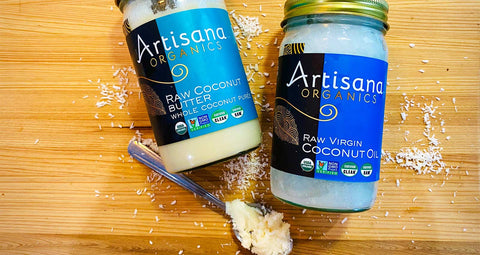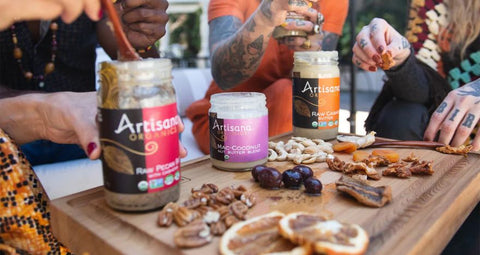You’ve heard it in the news and you’ve seen it on the shelves. One is oil and one is butter, or are they the same? Coconut is coconut right? Is there a difference between coconut oil and coconut butter?
The answer is yes, there’s a big difference! You can think about it kind of like this: there's a big difference between almond oil and almond butter, right? Same goes for coconut.
There’s definitely room for both coconut butter and coconut oil in any kitchen, but it’s important to understand what sets them apart from each other so that you can get the best uses out of each. Let’s talk about what’s so different about these delicious coconut products and how to use them both (because there are even some differences in how you use them!).
Coconut Oil
The biggest difference between coconut oil and coconut butter is the fiber content. Coconut oil is pulled from the meat, or flesh, of the coconut and contains none of the fiber found in the meat of the coconut. It’s typically an opaque soft solid at room temperature and a clear liquid when heated. Unrefined coconut oil (like ours) will have a mild nutty flavor that adds depth to whatever you’re cooking!
Coconut Butter
Coconut butter is the pureed meat of a mature coconut, so it contains not just the oil, but also the fiber and other nutrients generally found in coconut meat. Coconut butter has a creamy and thick texture that is rich in coconut flavor with a hint of sweetness. It will be harder in colder temperatures and softer when gently warmed.
Contrary to popular belief, there is no dairy in coconut butter. Artisana Coconut Butter is completely plant-based and vegan as it is a single ingredient straight from the coconut!
The texture of coconut butter changes with the temperature. When you first get it, it will probably be fairly solid. You can make it softer by gently warming it. To do so, try placing the jar near your stove while you’re baking, by putting the jar part way in a bowl of warm to hot water, or by leaving it in direct sunlight for a while. Stir it well.
(As always, be careful to check and attend to temperatures when heating anything with a stove or hot water!)
How to use Coconut Oil
Coconut oil has many uses, but among them, our favorite is definitely for cooking! Use it to sauté with your favorite vegetables, swap it into a baking recipe, or blend it with a cup of nut milk, matcha and cinnamon for a yummy and warming drink in the morning!
Coconut oil has also been known to be a great skin moisturizer (goodbye, chapped lips!), an easy hair conditioner, and an ingredient in homemade soap.
How to use Coconut Butter
Some of our favorite ways to use coconut butter include drizzling over a fresh cup of berries, topped with cinnamon over a baked sweet potato or winter squash, or as the original magic shell over your favorite coconut milk ice cream!
If you find yourself eating it by the spoonful straight from the jar, you’re not alone. It’s a super delicious treat with only 1 gram of sugar per serving and no added sugars whatsoever. It also tastes delicious in baked goods such a vegan chocolate chip cookies or banana bread!
We do not suggest sauteeing with coconut butter as the heat of the pan will quickly scorch the solids.
Pro Tip
One of our favorite things to do is to warm the coconut butter jar all the way through and then pour the coconut butter into ice cube trays. Put the trays in the fridge or freezer. Once the coconut butter is solid again, pop out the cubes and keep them in the fridge so they will maintain their shape. Now you can warm small portions at a time for your breakfast creations, or just grab a chunk of coconut butter for a quick snack!
Want more ideas for using coconut butter?
Check out the hashtag #howtoeatcoconutbutter over on Instagram.
Check out our Five Favorite Coconut Butter Recipes.


